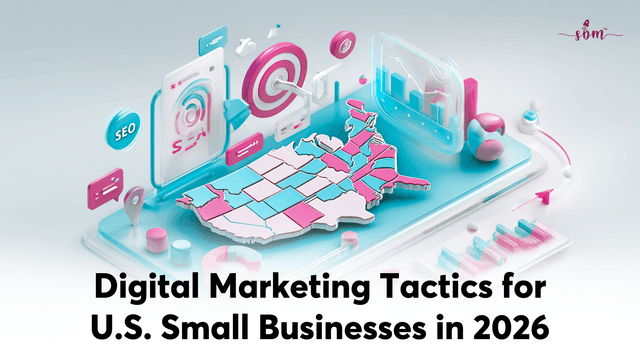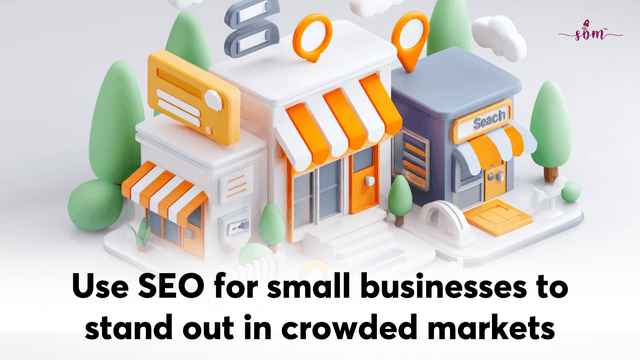Strategic Marketing Frameworks Every Small Business Should Use in 2026

Here is what operating a small business in 2026 looks like:
Constant rising competition
Constantly changing consumer behaviour
And the constant buzz of “what's trending"
To keep up with this, businesses do all they can: post on Instagram, run ads, and much more. But sales? They often remain the same. Here is the truth: most small businesses fail to reach their target audience, not because their products are bad, but because their marketing is scattered. This is where “strategic marketing" comes in. Simple, proven formulas that make things more organised.
Let's see more of it with Small Biz Marketing.
What is Strategic Marketing?
Imagine navigating a foreign land with no GPS or maps. Result? No sense of direction. This is what running a small business without proper strategic marketing looks like. Here is how having a digital marketing strategy framework helps businesses:
Helps plan your marketing goals
Helps you choose the right channel to deliver your marketing goals
Helps organise your marketing campaigns
Tracks your performance
Helps you adjust as per trends or customer expectations.
Takeaway
What is strategic marketing about? Having templates, tools, and marketing strategy frameworks that work.
What strategic marketing is not about? Guesswork and predictions.
Top Marketing Frameworks for Small Businesses
Having a marketing strategy framework that sounds super cool until you have to prepare one. Trust us, things can get super messy real fast, given that the trends are changing and so are customers’ demands.
But worry not, here are some already proven digital marketing strategy frameworks that make your work easy.
The 5Ps Marketing Mix
The 5Ps Marketing Mix, includes Product, Price, Place, Promotion, and People. Started as just 4Ps, now it includes Process and Physical Evidence as well, making a total of 7Ps.
How to use it?
1. Product
Define your product. List its features, quality, benefits, and what makes it distinct from competitors.
2. Price
Decide on the price of your product. Consider factors like cost of inputs, customer expectations, profits, and competitor prices to sum up.
3. Place
Decide where customers can find your product. Is it going to be available online, in a physical store, or both?
4. Promotion
How are you going to promote your product? Consider every possible channel like social media, e-mails, SEO, ads, etc.
5. People
Who delivers your product? Having the right people behind enhances the customer experience.
When to use it?
The 5 Ps marketing works wonders when planning to launch something new or revisiting your current offerings. It ensures businesses cover everything, starting from what your product is to how much you are the price and the delivery process.
Smart Move: Review your 5Ps every festival season or before announcing big sales. This is the time when you double your reach.
AIDA Model (Attention, Interest, Desire, Action)
Think of people who have never heard about your brand. What if you could turn them into your customers? Good news: you can, with one of the popular strategic marketing frameworks called the AIDA model. Here is what it is and how it works.
1. Attention
The A in AIDA is short for attention. Think of words that can instantly pique your customer’s curiosity. It could be about a certain product or about your brand as a whole. The basic motto is to grab the audience's attention. Easy way to do it? Discover words that generally pique the curiosity of the audience like “exclusive", “mystery", and so on.
2. Interest
Once you have the attention, the next step is to hold it. This can be done by making people know about your brand's benefits. A simple way to tell them what is in it for them. Best way to do it? Create a compelling hook. Avoid cliches and jargon. Make your brand more unique, relatable, and consider sharing customer success stories and behind-the-scenes videos.
3. Desire
The goal for this stage is simple: to turn the customers' liking into want. They saw your product, understood the benefits, and now they should be like “I want it".
How to do it? Do it the influencer’s way. Build trust. When your audience feels that someone out there genuinely loves and values your services, the chances of wanting the same for them increase. For instance, use before and after pictures. Showcase progress.
4. Action
Once you have garnered desire, give your audience ways to act on it. Make it easy for them to turn their “I need this" into "I am getting this.” Best way to do it? Write clear and compelling CTAs that also demonstrate the value of your products for the customers. For instance, shop now and get up to 75% discount.
Smart Move: AIDA can be really effective in designing several marketing campaigns, especially ads. Use it wisely to understand and improve your customers’ journey. Also, use them for your Instagram captions.
SMART Goals for Marketing
Still going for that “get more customers" agenda? Well, it's time to be more real and measurable now. Let's break down what SMART goals mean as marketing frameworks for small businesses.
1. Specific
Be clear about what you want; saying you want more customers is not enough. Instead, say “get 200 leads in Connecticut". See? More precise, clearer, and easier to understand.
2. Measurable
Having measurable goals is important. Why? Because you can track them and make changes or updates accordingly. This way you are better aware of your brand's success or the success of a strategy.
3. Attainable
Remember, your marketing goals can be big but they have to be attainable. The best way to do it is by assessing the qualities and abilities of your team members. See the problems, the forte, and other areas. Make sure you balance your goals, too easy can have lazy consequences, too unrealistic can strain your team. Remember, your goals should match your resources.
4. Relevant
Your marketing goals have to be equivalent to your business goals. Want more leads? The marketing goals should reflect that. Want more profile visits? Then, the marketing strategy has to be drafted that way. We say read your brand's vision and mission and keep them aligned with your business reports, ads, and other marketing tactics.
5. Time-Bound
Make sure your marketing goals are time-bound. They have to have a strict and clear deadline. Simple reason: it pushes accountability. But does much more than that. When your goals are time-bound, there is a sense of urgency that sparks action.
Smart Move: Track your marketing progress. This helps you understand if your SMART goals are realistic and working well enough. You can use free tools like Google Analytics.
Curious to read more about such marketing tactics? Small Biz Marketing offers a 7-step strategic marketing blueprint for free. Increase your online presence, grab your free e-book now!
Choosing the Right Framework for Your Business
If you've read this far, you know there are a variety of marketing frameworks for small businesses. However, finding the right fit for your brand can be the real game-changer.
Let us help you do it.
1. Sort Your Business Priorities
First, sort what is your business’s priority. Do you want to retain customers, increase brand awareness, or something else? Once you've sorted your priority, choose a marketing framework accordingly. Example: if you're running ads for better awareness and sales, AIDA can help.
2. Mark the Marketing Role
Next, understand the marketing team and the way they function. Ask questions like what they do or what their primary focus is. Whatever role your marketing team plays for instance, lead generation, customer retention, you can choose a framework that sits well with that role.
3. Defining and Measuring Marketing Success
Also, assess how the success of a marketing campaign is measured in your company. For instance, is it return on investment, customer acquisition cost, or something else? We suggest you pick a framework that can be measured as per the metrics used in your organisation.
4. Desired Impact
Have a clear idea about what impact you want out of your marketing strategies. For instance, if you simply want to scale up, using SMART Goals can help track and measure growth. Alternatively, for running ads, consider AIDA.
Conclusion
Doing the right marketing in the right way can be a bit overwhelming, given that this is how you make your brand and services visible to the audience. One wrong effort, and your products might not get the same visibility or attention as the competitor brands. This is where marketing strategic frameworks come to the rescue.
However, in cases where you feel a certain marketing strategy better suits your business but you lack the resources and team to implement the same, it is better to take some external assistance. Small Biz Marketing has been helping several small businesses with the same.
From brand optimization to telling your story the most authentic way, we do it all, in a way that resonates and feels organic to you. Here are some of our marketing services you may consider.
E-mail marketing
Strategic marketing
Social media management
Web design and development
Get In Touch with us at:
Frequently Asked Questions
1. What are strategic marketing frameworks for small businesses?
Strategic marketing frameworks for small businesses are nothing but structures that make your marketing tactics clearer, focused, and organised.
2. Why should small businesses use marketing frameworks in 2026?
Small businesses with a go-to B2B marketing framework can have several advantages.
It helps better align your marketing and sales.
Allows you to quickly market for new product or service launches.
Offers a better understanding of who your target audience is and what they want.
Gives you a competitive edge.
3. Which strategic marketing frameworks work best for small businesses?
Several marketing frameworks work well for small businesses. Some of these include having SMART business goals, 5 Ps to structure your business, AIDA, SWOT analysis, and more.
4. How can a small business choose the right marketing framework?
Small businesses can choose the right marketing frameworks based on the following factors:
Business priorities
Desired Impact from a marketing framework
Marketing role and capabilities of their team
How they measure marketing success
5. Can small businesses apply marketing frameworks without hiring experts?
Yes, they can. However, hiring experts gives you a competitive edge and saves time and effort that can be invested in other productive areas of the business.
6. What common mistakes do small businesses make when using marketing frameworks?
Here are some of the common mistakes most businesses make when choosing the right marketing frameworks:
Copying the marketing frameworks of others.
Not understanding the target audience, and what they want.
Ignoring the customer’s feedback
Not having SMART goals.


